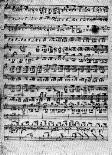composed 1833-35 - dedicated to Clara from Florestan and Eusebius
Introduzione, Un poco Adagio - Allegro vivace
Aria
Scherzo e Intermezzo,Allegrissimo
Finale, Allegro un poco maestoso
Schumann on Berlioz’ Symphonie Fantastique
Schumann's "Piano Sonata no. 1 in F-sharp
minor," Op. 11 was dedicated to Clara Wieck, who reacted enthusiastically
after first reading through it. Franz Liszt regarded the work as the best
of its genre since Beethoven. It is a large- scale,
outgoing work with an orchestral resonance, almost a symphony for piano.
The orignal sketch of the first movement he termed Fandango, after the
Spanish dance. “But the Fandango kept rolling around in my head. It is
a heavenly idea with divine images, and is more malleable than Maskenball,”
Schumann wrote in his diary in 1832. The actual sonata begins with
a call outlined by an ascending fourth, “perhaps a cry from my heart to
you”—so he described the sonata to Clara in a letter. This signal Schumann
would employ later as a final greeting in his last work, the "Geistervariationen"
that he also dedicated to Clara. This motif and a recurring motif built
on thirds comprise the germinating material of the entire sonata. Through
fine shadings in melodic line, articulation and rhythm, a language is created
that is only incidently recorded as musical notation. The transition to
the second movement is a good example: a falling fourth appears at the
end of the first movement, which then in a huge arch slowly transforms
into a rising figure before ending in the motif of thirds, with the "timpani"
motif echoing in the bass. Out of this develops a song, a love duet, which
is melodically related to the previously melancholy thirds. Then the "timpani"
motif changes abruptly into a delicate reminiscence. A high-spirited "Scherzo"
and a monumental "Finale" of orchestral density end the work. Schumann's
commentary in a letter was that he had ".poured much of my own heart's
blood into it." (Schumann to his publisher Kistner about the Sonata, op.
11)
scale,
outgoing work with an orchestral resonance, almost a symphony for piano.
The orignal sketch of the first movement he termed Fandango, after the
Spanish dance. “But the Fandango kept rolling around in my head. It is
a heavenly idea with divine images, and is more malleable than Maskenball,”
Schumann wrote in his diary in 1832. The actual sonata begins with
a call outlined by an ascending fourth, “perhaps a cry from my heart to
you”—so he described the sonata to Clara in a letter. This signal Schumann
would employ later as a final greeting in his last work, the "Geistervariationen"
that he also dedicated to Clara. This motif and a recurring motif built
on thirds comprise the germinating material of the entire sonata. Through
fine shadings in melodic line, articulation and rhythm, a language is created
that is only incidently recorded as musical notation. The transition to
the second movement is a good example: a falling fourth appears at the
end of the first movement, which then in a huge arch slowly transforms
into a rising figure before ending in the motif of thirds, with the "timpani"
motif echoing in the bass. Out of this develops a song, a love duet, which
is melodically related to the previously melancholy thirds. Then the "timpani"
motif changes abruptly into a delicate reminiscence. A high-spirited "Scherzo"
and a monumental "Finale" of orchestral density end the work. Schumann's
commentary in a letter was that he had ".poured much of my own heart's
blood into it." (Schumann to his publisher Kistner about the Sonata, op.
11)
© Franz Vorraber